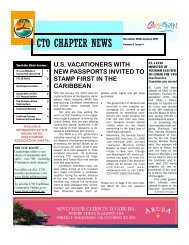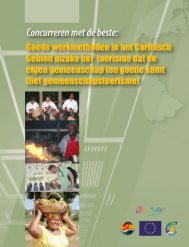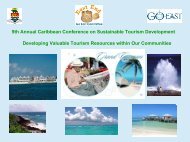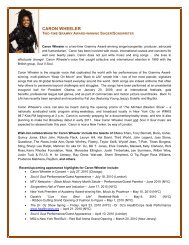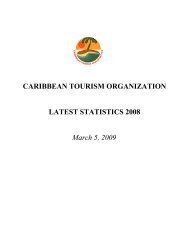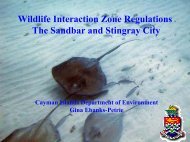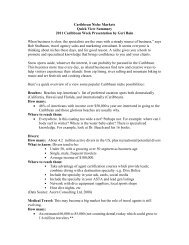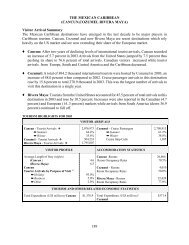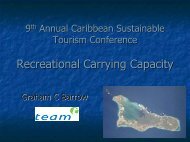Hi kids, it's Ziggy! IN THIS ISSUE - Caribbean Tourism Organization
Hi kids, it's Ziggy! IN THIS ISSUE - Caribbean Tourism Organization
Hi kids, it's Ziggy! IN THIS ISSUE - Caribbean Tourism Organization
Create successful ePaper yourself
Turn your PDF publications into a flip-book with our unique Google optimized e-Paper software.
L ! !<br />
Issue 16 April 2009<br />
A Tourrism Buullleetin ffoor CCaribbbeeaan C Chhiil d dren E m m a i ll :: zz ii gg g y @@ c a r i b t o uu r i ss mm . c oo m<br />
<strong>IN</strong> <strong>THIS</strong> <strong>ISSUE</strong><br />
• EEnvviirroonnmmenttal<br />
CCoorrnneerr:: Clliimaate<br />
Chhaanngee<br />
•• CCoouunnttrryy PPrrofille:<br />
BBeliizee<br />
• CCaarreeer Moovees:<br />
CCabbin Crreeww Membeerr<br />
•• FFun Tiime!!<br />
• Meeeett Jooyy aand<br />
NNiiccolaai<br />
<strong>Hi</strong><br />
<strong>kids</strong>, it’s<br />
<strong>Ziggy</strong>!<br />
I’m here to tell you<br />
about my wonderful<br />
visits exploring the<br />
<strong>Caribbean</strong>. You may not<br />
know it yet, but the region you<br />
call home is one of most exciting places<br />
in the world to travel around. There are<br />
over 33 countries and thousands of<br />
islands just waiting to be explored! Adventure<br />
and fun are just waiting to happen in every<br />
<strong>Caribbean</strong> destination!<br />
Did you know that intra- <strong>Caribbean</strong><br />
travel (i.e. where <strong>Caribbean</strong> persons<br />
travel from one <strong>Caribbean</strong> country to<br />
another for holiday, sports, business,<br />
special events etc.) is very important<br />
to our tourism business and that in the<br />
<strong>Caribbean</strong> 1.4 million of our total number<br />
of visitors come from our very<br />
own <strong>Caribbean</strong>. These visitors<br />
are called regional travelers, and<br />
you can be one too.<br />
So maybe you are wondering just<br />
how you’re going to get around<br />
the <strong>Caribbean</strong>? Well here’s how:<br />
Hop on an<br />
aircraft! Air<br />
travel is the most<br />
common…LIAT,<br />
<strong>Caribbean</strong> Airlines, Air Jamaica, Air Caraibes.<br />
Why not take a helicopter ride where you can<br />
view from the air the natural wonders of a<br />
<strong>Caribbean</strong> country?<br />
Sail away in a boat! Many<br />
<strong>Caribbean</strong> countries offer boat<br />
rides and ferry services to nearby<br />
islands…For more luxurious<br />
travel, why not take a cruise<br />
around the <strong>Caribbean</strong>!<br />
Jump in the car!<br />
For countries that are<br />
connected by land, like the<br />
Dominican Republic and<br />
Haiti or Guyana and<br />
Suriname, visiting<br />
another country is<br />
as easy as taking a<br />
drive across the<br />
border. If your home is<br />
an island, why not take a road-trip around your<br />
own home country & discover unknown places?<br />
You can be a domestic tourist!!<br />
In this issue let’s join Joy (from<br />
Guadeloupe) and Nicolai (from Nevis) on<br />
their <strong>Caribbean</strong> adventures!<br />
Take care,<br />
<strong>Ziggy</strong>
FUN damentals in ��ur <strong>Caribbean</strong>!<br />
There is SO much more to the <strong>Caribbean</strong> than<br />
just sun, sea and sand! For instance:<br />
Have you ever……<br />
Climbed the Dominican Alps, home to<br />
Pico Duarte, the highest peak in the<br />
<strong>Caribbean</strong>?<br />
Pico Duarte (10,127 feet or 3,087<br />
metres high)<br />
Visited the Curaçao<br />
Ostrich Farm where you<br />
can touch the birds,<br />
feed them or even eat<br />
ostrich meat or have an<br />
ostrich omlette?<br />
2 Making Waves A <strong>Tourism</strong> Bulletin for <strong>Caribbean</strong> Children<br />
Visited an<br />
Amerindian<br />
village in<br />
Suriname?<br />
Rode a tram<br />
car through<br />
the lush<br />
tropical forests<br />
in Dominica?<br />
Eaten big,<br />
juicy<br />
lobsters in<br />
St. Lucia?<br />
Dived<br />
underwater in<br />
Grenada to<br />
see its<br />
underwater<br />
sculpture<br />
garden?
Architecture<br />
<strong>Caribbean</strong><br />
across the<br />
A seemingly big word, architecture refers to<br />
tthhee ddeessiiggnn aanndd ccoonnssttrruuccttiioonn ooff bbuuiillddiinnggss, and in<br />
the <strong>Caribbean</strong> we have a wide variety of styles<br />
and designs for our buildings that reflect our<br />
multi-cultural heritage. Tourists who come to<br />
our countries like to visit and learn about our<br />
churches, plantation houses, forts and other historic<br />
buildings that we sometimes take for granted.<br />
Can you tell what buildings these are and where<br />
they are located?<br />
5<br />
2<br />
Answers:<br />
1. Willemstad, capital of Curacao (Dutch <strong>Caribbean</strong>)<br />
2. The Red House (parliament building) in Port of Spain, Trinidad<br />
3. A Mosque in Bushlot, Guyana<br />
4. El Morro Fort in Old San Juan, Puerto Rico<br />
5. A chattel house in Barbados<br />
Making Waves A <strong>Tourism</strong> Bulletin for <strong>Caribbean</strong> Children 3<br />
4<br />
1<br />
3
The<br />
<strong>Caribbean</strong><br />
Adventures<br />
of<br />
Where have<br />
you<br />
travelled<br />
in the<br />
<strong>Caribbean</strong>?<br />
I have been to Barbados to visit<br />
Uncle Julian. In July 2008, I was<br />
in Kingston, Jamaica with my Aunty<br />
Lorna and Jannelle. I went to the<br />
Edna Manley Institute of<br />
Performing and Visual Arts. I liked<br />
it a lot! I have also visited:<br />
• Trinidad for Carnival and every<br />
year I visit my aunt there.<br />
• Martinique to visit my family.<br />
• In 2007, I went to a summer<br />
camp in St. Kitts, with Mummy,<br />
who had taken a group of<br />
children from Guadeloupe.<br />
• In 2006 I went to Saint<br />
Domingue (Santo Domingo in<br />
the Dominican Republic) to<br />
participate in another summer<br />
camp my mother set up.<br />
• In May 2008 we went to the<br />
St. Lucia Jazz Festival and also<br />
visited my Aunty Lorna and<br />
Uncle Franklyn, Lonnel and her<br />
daughter Eva.<br />
<strong>Hi</strong>, my name is Nicolai<br />
Williams. I’m from the<br />
island of Nevis, in the<br />
Federation of St. Kitts &<br />
Nevis. I am 12 years old.<br />
I travelled to Antigua<br />
during my summer<br />
vacation in 2008 to<br />
attend a Pathfinder<br />
Camporee. I didn’t get<br />
there by plane, but by<br />
boat, on the M.V. Sea<br />
Hustler. I didn’t really<br />
enjoy the trip because<br />
4 Making Waves A <strong>Tourism</strong> Bulletin for <strong>Caribbean</strong> Children<br />
Joy Chicate-Moibert,<br />
9 years, Guadeloupe<br />
BByy wwhhaatt aaiirrlliinneess ddiidd yyoouu<br />
ttrraavveell aanndd ddiidd yyoouu eennjjooyy<br />
yyoouurr fflliigghhttss??<br />
To go to the <strong>Caribbean</strong> Mummy<br />
uses LIAT. You must get up early<br />
to take the flight. To go to Jamaica,<br />
I travelled to Pointe-à-Pitre in St<br />
Martin with my grandfather Pappy<br />
Michel and I continued my travel<br />
alone to Kingston, with a flight<br />
attendant to take care of me. It<br />
was a long, but enjoyable flight.<br />
WWhheerree aanndd hhooww lloonngg ddiidd yyoouu<br />
ssttaayy??<br />
I always stay at my mother’s<br />
friends’ house or with family.<br />
WWhhaatt aarree ssoommee ooff tthhee<br />
aaccttiivviittiieess yyoouu ddiidd iinn ootthheerr<br />
CCaarriibbbbeeaann iissllaannddss??<br />
Summer camp, carnival, visiting<br />
family and friends, shopping,<br />
sailing, camping in Martinique.<br />
WWhhaatt ddiidd yyoouu eennjjooyy mmoosstt??<br />
Meeting other children, speaking<br />
English, playing Mas with my<br />
Mummy and friends.<br />
the seas were quite<br />
rough. When we arrived<br />
in Antigua, we were<br />
driven to a campsite<br />
where we would spend<br />
the week.<br />
Some of the activities<br />
were games such as<br />
tennis ball relay, or<br />
sports such as swimming,<br />
cycling and athletics. We<br />
also had to wash dishes<br />
and clean up the<br />
WWoouulldd yyoouu lliikkee ttoo vviissiitt mmoorree<br />
CCaarriibbbbeeaann ccoouunnttrriieess??<br />
Yes, because Mummy says that I<br />
am a <strong>Caribbean</strong> girl and should<br />
speak two other languages very<br />
well, English and Spanish and I<br />
should know my region where I live<br />
well. Then I understood and I told<br />
mom that it was a good idea. Next<br />
year my mother is going to try to<br />
organize a trip to Dominica for my<br />
school, Thomas Bouillante in<br />
Guadeloupe. I hope she would be<br />
successful and would find help to<br />
house all 40 children in a small<br />
hotel and we could visit the Carib<br />
Reserves.<br />
Merci!<br />
Muchas Gracias!<br />
Thank You!<br />
Nicolai Williams, 12 years, Nevis<br />
campsite. A highlight of<br />
the week was the “March<br />
of Witness”. The closing<br />
ceremony was<br />
spectacular and ended<br />
with a display of<br />
fireworks.<br />
I look forward to visiting<br />
other <strong>Caribbean</strong> islands<br />
and learning about their<br />
distinctive cultures and<br />
natural environment.
Country Profile: Belize<br />
Mother Nature’s Best Kept Secret<br />
Beautiful Belize is a diverse<br />
country of only 301,270 people,<br />
living in 8,867 sq miles. Though<br />
Belize is part of the <strong>Caribbean</strong><br />
Community (CARICOM), it is<br />
located in Central America. Its closest neighbors are Mexico,<br />
Guatemala and Honduras. Along the entire east coast of Belize<br />
lies the <strong>Caribbean</strong> Sea. Belize’s capital, Belmopan, is also known<br />
as the “Garden City” because of its colorful flora and many<br />
flamboyant trees.<br />
Getting to Belize is very easy. Most visitors travel by air, but you can also get<br />
there by road and by boat. In 2008<br />
Belize received 204,219 tourists to<br />
their country and from January to<br />
October 2008, 465,325 cruise<br />
visitors. Some of the fun things<br />
visitors do while in Belize are:<br />
• Visit Altun Ha and other Maya<br />
ruins<br />
• Go tyre tubing in caves<br />
• Snorkle or scuba dive in the<br />
Belize Barrier Reef, the second<br />
largest barrier reef in the world<br />
• Visit the Primate Centre where<br />
you can observe the howler and<br />
spider monkeys<br />
Other than tourism, important<br />
sectors in Belize include agriculture<br />
and forestry. Belize exports sugar,<br />
citrus, bananas and fish products<br />
such as lobster, as well as timber<br />
such as mahogany and chicle (the<br />
wood from which chewing gum is<br />
made).<br />
Belize is the only country in Central<br />
America to have English as its<br />
official language. Spanish and Kriol<br />
are also widely spoken. The Belizean<br />
Creole or Kriol are the mixed<br />
descendents of Europeans and<br />
African slaves who came to Belize.<br />
Today almost 24% of Belize’s<br />
population is Kriol.<br />
The Coat of Arms<br />
- adopted on September 21st, 1981<br />
The National Tree of Belize is the<br />
majestic Mahogany tree, which grows<br />
up to over 100 feet tall. It also appears<br />
rising above the shield on their Coat<br />
of Arms. During the 18th and 19th<br />
centuries, the mahogany industry was<br />
the major industry in Belize. Its National<br />
Motto, “Sub Umbra Florero,” which also<br />
appears on the Coat of Arms, is Latin meaning,<br />
"Under the shade (of the mahogany tree) I flourish.” Supporting the<br />
shield are two woodcutters, the one on the right is holding a paddle,<br />
and the one on the left is holding a beating axe..<br />
Altun Ha (the<br />
photo on the<br />
right) is the most<br />
visited Maya site<br />
in Belize. In<br />
ancient times<br />
Belize was the<br />
center of the<br />
Maya world and<br />
was ruled by<br />
powerful kings<br />
who they<br />
believed to be<br />
living gods. The<br />
nobility, priests<br />
and warriors<br />
lived in palaces, temples and<br />
pyramids, which were painted<br />
in the Maya sacred colours: red,<br />
blue, green and yellow, while<br />
everyone else lived in farming<br />
villages. It is estimated that<br />
The Maya in Belize<br />
about 2 million Maya lived in<br />
what is now Belize. Today there<br />
are 3 distinct Maya groups in<br />
Belize, each speaking their own<br />
dialect of the Maya language<br />
and they account for 11% of the<br />
population.<br />
Making Waves A <strong>Tourism</strong> Bulletin for <strong>Caribbean</strong> Children 5
Belize<br />
Colour this Maya Artwork in the traditional Maya colours of red, yellow, blue<br />
and green, then use as a wall decoration!<br />
6 Making Waves A <strong>Tourism</strong> Bulletin for <strong>Caribbean</strong> Children
ENVIRONMENTAL CORNER:<br />
CLIMATE CHANGE AND GREENHOUSE GASES<br />
The Earth is wrapped in a blanket of air called the<br />
‘atmosphere’, which is made up of several layers of<br />
gases. The Sun is much hotter than the Earth and<br />
it gives off rays of heat (radiation) that travel<br />
through the atmosphere and reach the Earth. The<br />
rays of the Sun warm the Earth, and heat from<br />
the Earth then travels back into the atmosphere.<br />
The gases in the atmosphere stop some of the heat<br />
from escaping into the space. These gases are<br />
called greenhouse gases because it works the same<br />
way as a greenhouse, trapping heat inside our<br />
planet Earth.<br />
Greenhouse gases are very important and are<br />
mainly:<br />
� Water vapour – produced when water is turned<br />
into a gas. This occurs naturally in the<br />
atmosphere.<br />
� Carbon dioxide - produced naturally when<br />
people and animals breathe. Plants and trees<br />
absorb carbon dioxide to live. Volcanoes also<br />
produce this gas.<br />
� Methane - comes from cattle as they digest their<br />
food. The gas also comes from fields where rice<br />
is grown and from our landfills/garbage dumps.<br />
� Ozone – occurs naturally in the atmosphere<br />
Some greenhouse gases have very harmful effects on<br />
Earth, such as:<br />
� Burning fossil fuels such as coal, oil and natural<br />
gas, which release carbon dioxide into the<br />
atmosphere. Cutting down and burning trees also<br />
produce a lot of carbon dioxide.<br />
� Greenhouse gases called ‘‘cchhlloorroofflluuoorrooccaarrbboonnss’’<br />
(CFCs) which are used in aerosols such as<br />
hairspray cans, fridges and in making foam<br />
plastics. These gases are dangerous because<br />
small amounts can trap large amounts of heat.<br />
Because there are more and more greenhouse gases<br />
in the atmosphere, more heat is trapped which makes<br />
the Earth warmer. This is known as ‘‘gglloobbaall wwaarrmmiinngg’’.<br />
With more heat trapped on Earth, the planet will<br />
become warmer, which means the weather all over<br />
the Earth will change.<br />
Here is how we can help people, plants and animals<br />
survive global warming:<br />
� DDoo plant trees in your gardens, schools<br />
and parks<br />
� DDoo recycle paper, plastic, glass and<br />
metals<br />
� DDoo remember to turn off the lights when<br />
you leave the room<br />
� DDoonn’’tt leave electrical equipment, like TVs<br />
and computers, even your chargers<br />
plugged in or on standby, because they<br />
use up electricity<br />
� DDoonn’’tt ask to be driven short distances.<br />
Walk or ride and get some exercise and<br />
� DDoonn’’tt buy products that have CFCs in them.<br />
Making Waves A <strong>Tourism</strong> Bulletin for <strong>Caribbean</strong> Children 7
C����� M����: Haydie Moses, Cabin Crew Member<br />
1. What is your job all about and which<br />
airline do you work for?<br />
I am employed with Liat (1974) Ltd., and I am<br />
a Cabin Crew Member, formerly known as Air<br />
Hostess, Stewardess, Flight Attendant; but<br />
we are now referred to as Cabin Crew. My job<br />
entails being on board the flight primarily for<br />
safety reasons. Secondly, to offer my<br />
company's passengers the best in customer<br />
service.<br />
2. How long have you been working as a<br />
Cabin Crew Member?<br />
I re-joined the company in 1995.<br />
3. What is a typical day for you at work?<br />
A typical day at work for me can be considered flexible. Every day<br />
is very different. The time at which I may start work can differ, the<br />
destinations that I travel to are not always the same. The crew that<br />
I might work with might be colleagues I have not worked with for<br />
months. A typical day could start at 4 a.m. Here is what I do:<br />
• I check in at our Operations Department, sign in, find out who I<br />
am working with and what aircraft we will be using etc.<br />
• Get to the airport, go through security<br />
• Get on board at least one hour before departure and conduct<br />
my emergency equipment checks. (That would include<br />
ensuring all the necessary equipment is in place; an example<br />
would be, to ensure all life jackets are in their stowed positions<br />
in the unlikely event that we had an emergency landing)<br />
• Check that catering is ready<br />
• Allow passengers to board the flight<br />
• Greet passengers as they embark, check boarding passes and<br />
assist with the seating where and when necessary.<br />
• Do a passenger count, check that aircraft documents have<br />
been signed and that the door is closed<br />
• Do a demonstration of the safety procedures, inform them of<br />
the flight number, destination, flight time, crew's name and<br />
8 Making Waves A <strong>Tourism</strong> Bulletin for <strong>Caribbean</strong> Children<br />
welcome them on board.<br />
• In-flight service depending on the<br />
duration of the flight. Most of our flights<br />
are very short. Once it is 45 minutes or<br />
more, then we offer juice, coffee or tea<br />
and on most flights we have a saleble<br />
bar.<br />
• The flight lands on one of our tropical<br />
<strong>Caribbean</strong> islands, passengers are<br />
greeted goodbye and since our flights<br />
stop in several islands then the process<br />
continues.<br />
4. What do you like most / least about your<br />
job?<br />
The fact that I am able to serve our<br />
<strong>Caribbean</strong> people. Secondly, I get to meet people from all walks of<br />
life. I am able travel to various islands and experience different<br />
cultures. Least would be that since I am a family oriented<br />
individual, it takes me away from my family, but I have grown to<br />
know that in life you must make some sort of sacrifice in order to<br />
get ahead.<br />
5. What type of training did you have to undergo to become a<br />
Cabin Crew Member?<br />
It is roughly a six week course, where you undergo training in<br />
emergency procedures, first aid, general knowledge and<br />
knowledge of the type of aircraft. You must pass the exams with at<br />
least 85% and do annual re-current training.<br />
6. What advice would you like to give young persons who would<br />
like to become a Cabin Crew Member?<br />
I would advise them to give this some long, hard, serious thought<br />
before getting involved. As a Cabin Crew one must be a “people”<br />
person, ie you must have tolerance and patience and the ability to<br />
operate under stressful conditions.<br />
CARIBBEAN TOURISM ORGANIZATION<br />
One Financial Place, Collymore Rock,<br />
St. Michael, Barbados<br />
Tel: 246-427-5242<br />
Fax: 246-429-3065<br />
www.onecaribbean.org<br />
www.caribbeantravel.com<br />
email:ctobar@caribsurf.com



